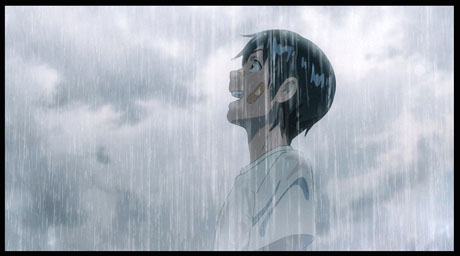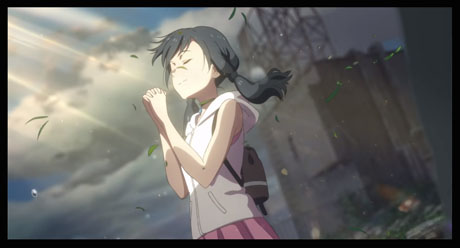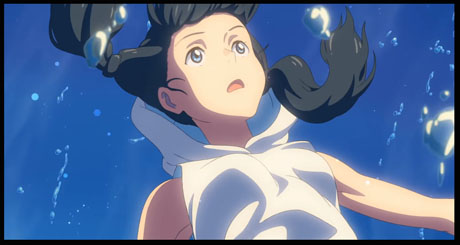
It’s the summer of 2011. The long-range weather forecast for Tokyo is rain. And it’s not. Going to. Stop.
Such is the sad state of affairs in Weathering With You, from Japanese director Makoto Shinkai. His previous work, Your Name, became the first anime not directed by Hayao Miyazaki to earn more than U.S. $100 million at the Japanese box office, achieving $348 million worldwide. With his latest film, Shinkai presents another love story. This one is between Hodaka Morishima, a runaway teen, and Hina, a girl he meets working at a McDonald’s in Tokyo. She has the uncanny ability to stop the rain, at least temporarily.
Weathering With You is Japan’s official International Feature Film entry to the 2020 Academy Awards. The film was shown at the Animation is Film Festival in Los Angeles on October 18. At the Q&A afterward, the director talked about animating the water effects so abundant in the film.

“When it rains in animation, it is so much harder because when there’s a window there’s thousands of raindrops on it,” he said. “If you have an umbrella, the water falls on it and it might roll down. So it’s really hard. For a lot of the animation on this film, we had 2D animators—hand-drawn animators—as well as CG animators, and it was a challenge to make sure that you couldn’t tell which was hand-drawn and which was CG.”
The following day, Makoto Shinkai discussed his new film, and I continued the topic of his approach to animating water.
Bob Miller: I was impressed with the animation of the rain. At the screening last night, you had mentioned difficulty of merging hand-drawn with CG rain. Could you talk about that?
Makoto Shinkai: Yeah. So basically in Japan, just like how we used to do it, we had hand-drawn animation with painted backgrounds with characters on cels. And even though that process is shown as the CG, we do feel like we put a lot of effort into how do we blend in or which way do we blend in more. Like do you want to blend in towards the background at the CG? Or do you want to blend in more towards the … Or lean towards more the character drawn by hand? So basically that mix and then the blending is really an important part of our project.
BM: What software did you use for the CG?
MS: 3D Studio Max is used mainly, but depending on the staff, it differs sometimes. But they are mostly like the one that American animators use, as well. We also use Blender. And then we composite this to that remains like Blender and 3D Studio Max by using Adobe After Effects.
BM: Well, you did a very good job.
MS: Thank you.

BM: Let’s talk about your career. What inspired you to be involved in animation in the first place?
MS: I think if I go back, like way back, on how I got really interested in animation, it was Miyazaki’s Castle in the Sky. I saw that when I was in middle school and I was like, “Wow. I can’t believe that something so interesting could be made.”
And the next thing that inspired me was watching Neon Genesis Evangelion. It was maybe around when I just started working, or maybe just after graduation, is when I saw it. But I was in awe with the animation. But it was really about Hideaki Anno’s method on how to use his lack of time into the cel. So he’ll have a background with just the character just having a monologue. So he used that as an advantage of not having enough time to animate. So I was like, “Wow. If he could do something like this, I think that I could make my own film too.”
BM: So, how did you become a director?
MS: When I first started working, I started working for a game company [Falcom] as a designer. And I worked on this opening movie for one of the games, using After Effects. But it wasn’t enough for me. I wanted to really put myself into my story into the movie. So then I thought, “Okay. Why don’t I just make something on my own?” So while I was working at the game company, at night I just started making my own movie [She and Her Cat, 1999]. And then I started turning them into competition and they started winning awards. And I was like, “Oh, yeah. I think I might be able to do this, like quit my job.” And then that’s when I made Voices Over a Distant Star (2001), which is about 20 minutes. That was my first film. And then from there, I just started making more films on my own. And that’s how I became a director.
BM: What inspired you to make Weathering With You?
MS: There’s a few things that inspired us. I think the biggest thing was climate change. Yeah. Climate change really became a huge part of our lives and we see it here. Because every summer in Japan, we always have a lot of rain and water-related disasters because of it. So, every year they’re talking about climate change and how we have to do something about it. But we also know that it’s not something that we could turn back in a few years. So it has happened. And then how do we live in this crazy world that we have created? And how do especially the young people live in this crazy world? That’s what I started thinking about when I started working on Weathering With You.
BM: So it was a coincidence that this year you had lots of rain in Japan, right?
MS: Yeah. Right. Yeah. So many people who saw Weathering With You this summer and then when the typhoon came, everyone was like, “Oh, it’s exactly how it was depicted in Weathering With You.”
BM: So it is timely. Last night, somebody asked you about the ending of the film. And you honestly said that adults were upset with the ending, that Tokyo was partially submerged. What is your reaction to that?
MS: So adults getting angry about the ending, it was already predicted. But it’s not like I tweet back at them or anything. I just read it and say, “Oh, this is how they’re feeling.” So, that was already predicted. So I wasn’t that surprised. What I was surprised about was that there was less young people who were angry about the ending. I thought maybe the young people, maybe half would hate it, half would love it—but more loved it than hated it. So… that was surprising but also a little disappointing because I wanted to have the different generations have the different opinions and have a little bit more of a debate. So I was a little disappointed in myself that I wasn’t able to create that debate a little bit more.

BM: What kind of research did you do for this film?
MS: I did have a meteorologist as a consultant. So, when I do the storyboarding, I make a video of the storyboarding. 110 minutes of video storyboard. And so I show that to a meteorologist. If there were any mistakes on how like the clouds were shaped or how the rain was falling, that was pointed out and I fixed it.
For example in high pressure, the wind would turn clockwise or the wind will blow clockwise, and in low pressure, the wind blows the other way, counterclockwise. And this just really has to do with the lower hemisphere and the higher hemisphere. And that is something also was pointed out by the meteorologist.
BM: Interesting. Can I ask what the budget was?
MS: Yeah. Actually the budget is not public information. But it was bigger than Your Name. But it’s probably smaller than Disney or Pixar. (chuckles) Way smaller than Disney.
BM: Okay. So you have some characters from Your Name in this. [Taki and Mitsuha] So they’re in the same universe, so to speak?
MS: Yes. So the timeline was, with Weathering With You, it occurred in 2011. So when you see a calendar in the background, it’ll say 2011. I wanted to just show, oh, what the Your Name characters are doing because they’re also in Tokyo. And it’s just a reflection of what they’re doing at the time of Weathering With You. I guess you can say that’s it a shared timeline or universe as you would say. But I didn’t really think of it as a whole big, “I’m going to create this universe that’s shared.” Because so many people watched Your Name and loved it, it was more of fan service.
But I don’t want it to be like the same universe or definitely say this is the same universe. Because then you’ll have… In Japan, there was a comment that [some land] had broken off and it causes disaster. And also like Tokyo was submerged in water, it’s going to really be like a crazy world. (laughs) So … I don’t think that’s a good idea.
BM: Okay. Did you storyboard the whole thing yourself?
MS: Yeah.
BM: Awesome.
MS: Ten months to draw.
BM: Wow. Okay. What do you know now that you wish you had known when you began your career?
MS: I don’t know if I’ve been asked that question before. But I’ve never worked at an anime studio. So I don’t have something like a mentor or teacher. One time, I do feel like maybe if I had a teacher, I could have made something better. But also I felt that little bit maybe if I had worked at an anime studio maybe I wouldn’t have become a director.
BM: Okay. Last year, I spoke with Mamoru Hosoda and he was afraid that he was going to have start making CG films, instead of hybrid hand-drawn/CG. Do you feel that’s the direction going for Japanese animation?
MS: Yeah. Just like Mr. Hosoda said, there are going to be less people who can hand draw and it is something that us, as Japanese animators, have to work on. And I am sort of interested in anime creating a whole CG movie. But then, I think the Japanese anime fans, whether in Japan or United States, they like the style of how it looks. So it’s really how to incorporate that CG into keeping that style of look. So, I think it’s something we do have to work on.
BM: Do you prefer working in hybrid animation?
MS: Yeah. So I guess what elements you incorporate CG more. In Weathering With You, in the scenes there’s like a crowd walking through Shinjuku. That is done in CG. Although, we try to make it not look like CG. I think we’re going to have to incorporate more CG into the background. But, regarding like characters, do I want to make them CG? I’m still unsure of that. For our choice, I do prefer hand-drawn characters more.

BM: That’s great. For an audience here in America, what would you say makes your film special? Why should people come to see Weathering With You, in your opinion?
MS: Talking to fans and getting images, I do see how the USA fans like Japanese animation because it’s so director-centric and creatively more free. We do have the goal to be more like Hollywood and have this massive feel and make lots of money, too. But I think Japanese animation has always been made in this closed, very specific environment and then that style has become our strength now. While we do want to be global, I think the fans actually like the part that we’re not so globalized and that we have this distinct style, is how I feel.
BM: Yeah. Mr. Miyazaki prefers to be more Japanese-centric. He doesn’t care about the global market. But do you prefer the global market?
MS: It’s hard to say. With Weathering With You, I really made for it the 2019 young people living in Japan who watched it and I really felt like if they could enjoy for that one summer, that’s fine. If they forget about the movie the next year, that’s fine. I just wanted to make something that was relatable in that generation. But I mean, it is nice to have it go outside of Japan and have more people internationally see it. And then also because of the population decline in Japan, it would be better to collaborate more with international, whether it be through funding or whether it be through international artists. So I am interested. Or maybe that is something that we have think about and the direction that we might have to go.
BM: What are your goals now?
MS: Well, so when you ask about goals, maybe you’re referring to the Oscars but that is such an unknown world to me. So I’m not really going to touch it. But I do have the wish for a lot of people to see my movie. So Weathering With You did well in the box office in Japan. But it didn’t do as well as Your Name. So, that was a little bit of something actually that I wanted to work on. Because I do still want people to choose my movie as the one to see. In the summer, if it is at the movie theater, if there is Toy Story 4 and then my movie, I do want people to say, “I want to watch my movie.” So that is, I guess, your goal.
BM: That’s great. Is there anything else that you want people to know about your film? Or Weathering With You? Or anything else?
MS: (thinking) That’s a hard question. Yes. That is a hard question because I think the stuff I want to say about myself or my films is all in my films. So, if everyone could just watch my film and see how they feel, that’d be great.
BM: What would you advise people who want to be involved in animation?
MS: I really do believe that animation should be for young people. The anxiety the young people feel, the fear, the admiration, everything, I really feel like animation enforces or enhances that emotion. So, my advice would be, “Keep the young heart that you have. Keep the emotion or remember it. And I think that will be useful when you start making animation.”

Makoto Shinkai – with W.R. Miller
In Japan, Toho released the film July 19, 2019, and earned the equivalent of US $126.5 million as of October 20. In the U.S., GKIDS will release Weathering With You to theaters beginning January 17, 2020 after select preview screenings January 15 and 16.
Special thanks to Satsuki Yamashita, translator; Hilda Somarriba and Melanie Márquez, Prism Media Group; and Akihiro Takeda, Head of International Sales, Toho Co., Ltd.
- INTERVIEW: Aaron Ehasz, Justin Richmond on “The Dragon Prince: Mystery of Aaravos”: The Right Choice for the Voice - March 20, 2024
- INTERVIEW: “The Dragon Prince” Influences, Inspirations, and the Mystery of Simpson - March 11, 2024
- INTERVIEW: The Magic of Her Voice: Paula Burrows of “The Dragon Prince” - October 4, 2023


 November 5th, 2019
November 5th, 2019  W.R. Miller
W.R. Miller  Posted in
Posted in  Tags:
Tags: 






